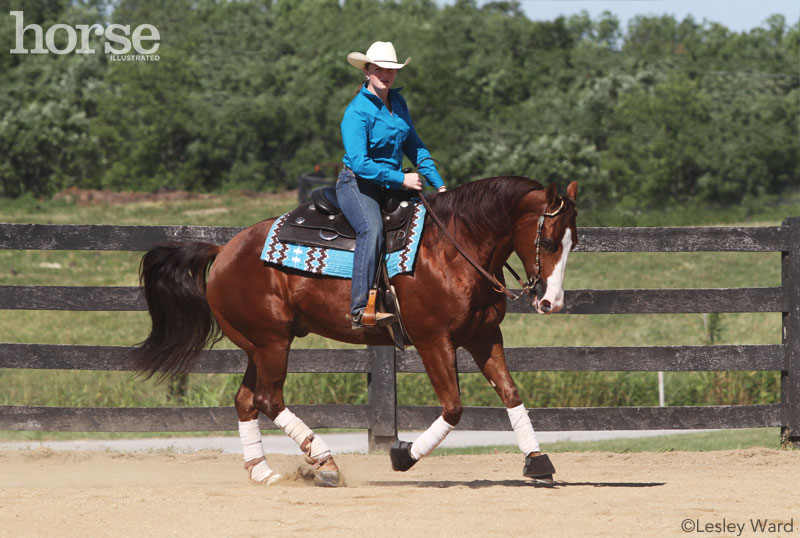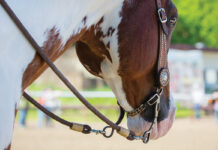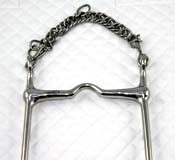When shopping for riding clothes, you know that what you buy needs to be sturdy, easy to wash and comfortable. Choosing the right saddle pad begins the same way — by looking at the practical details of fit and intended use. What kind of riding will you be doing? Specialty saddle pads are made for every way you can ride a horse. What kind of fit do you need? Does your horse have a conformation problem or old injury that needs special protection? What kind of environment will you be riding in? Horses working in tropical heat and humidity may be more comfortable with a different type of saddle pad than those in the northern mountains. Do you like natural fabrics, such as wool and cotton, or do you place your trust in the latest technology and the newest synthetic materials?

Saddle Fit Is Paramount
“So many horses’ hearts are bigger than their hurt that you may not realize the saddle doesn’t fit,” says Ron Wade of Fabri-Tech Inc., designer of the Cush-N-Air pad. And saddle fit can change with the horse’s seasonal shifts in weight and conditioning, so don’t assume a saddle/pad combination that fit at one time always will, cautions Wendy Murdoch, senior Centered Riding instructor and practitioner of the Linda Tellington-Jones Equine Awareness Method. ”A pad isn’t a one-time fix,” says Murdoch. “Horses change.”
Typically, a horse will move much better with a new saddle pad, because the pressure is taken off irritated areas. “If your saddle doesn’t fit well, two weeks to six months after adding a new pad, pressure points will show up again in new locations,” says Murdoch. “It just takes a while for the horse to become sore enough to show you.”
Depending on the movement of horse and rider, saddle-created pressure can alter blood flow in the horse’s back. “Muscles naturally respond to point pressure by tensing, thus inhibiting spine flexibility,” says Mary Bromiley, a physiotherapist who works with Tipperary Manufacturing Inc., maker of the Air-Ride pad. Equalizing weight allows for maximum power and length of stride, she says.
According to one study, horses can sustain the intensity of tourniquet-like pressures for up to two hours before signs of damage appear in tissues. “I’ve seen significant damage and significant performance problems created by much less pressure over much shorter periods,” says Joyce Harman, D.V.M. of Harmany Equine Clinic in Washington, Virginia. Hunters ridden only 20 minutes a day can have severe tissue damage from a poorly fitting saddle, says Dr. Harman. Studies on humans show that 3/4 pound of pressure per square inch for two hours can cause bedsores, which indicates significant tissue damage. We are probably looking at pressures similar to that for horses, she says. Early signs of damage include white hairs, heat spots, hair loss and uneven sweat patterns that you may notice after removing the saddle.
Too Much or Too Little
Ideally, a pad should add cushioning rather than change a saddle’s balance or pressure. If the saddle tree is too narrow, any pad can make the fit worse by simply shifting the location of the pressure. Adding more padding under a saddle that doesn’t fit right is like putting more socks inside a tight shoe. Too much padding can put pressure directly on the horse’s spine and the nerves that lie along it.
If you’re trying to fix a chronic problem with a pad, first check to ensure the saddle is wide enough, places no pressure on the withers or spine, doesn’t interfere with shoulder movement, fits the contours of the horse’s back and distributes weight evenly along the long back muscles. Ideally, there should be at least 2 inches of clearance in the saddle gullet, and preferably 3 inches. “It’s hard to find that much width,” says Murdoch. Many close-contact saddles have an extremely narrow gullet, leaving the panels sitting directly on the horse’s spine.
If the saddle pad is too thick behind, it will raise the back of the saddle, putting pressure on the withers and the point of the tree, pinching the withers and shoulder. Too much padding can make the saddle feel unstable to the rider. Riders may compensate by overtightening the girth, causing both physical and behavioral problems in the horse.
Thicker saddle pads can be helpful for older or out-of-condition horses that lack muscling. Padding essentially creates artificial muscle that can be adjusted with a thicker or thinner pad as the horse’s body shape changes. “But a horse can’t develop muscling where there is a pressure point,” Murdoch says. Pads that are the same thickness throughout may not allow enough room for the horse’s withers. On a thin horse with poor muscling, a pad with the same thickness throughout may put pressure on the spine where you can’t see it. “To distribute the saddle’s pressure as evenly as possible, western pads should fill in the middle as opposed to making a bridge between the front and back of the saddle,” Murdoch says.
Some pads fold over the withers for extra cushioning. Adding that second layer may still allow the saddle to sit level, but it can pinch the shoulders and create a bridge between the back and shoulders. Folding or layering several pads can create other problems. Adding a half pad that is shorter than the saddle may create a pressure line or distribute the saddle’s weight over a smaller area. The same thing happens if a single pad isn’t big enough for the saddle. Additional pads may press up into the gullet and functionally narrow it, adding rather than removing pressure.
Western saddles are designed to be used with extra padding to support the rigid tree. Using partial or multiple pads under a western saddle also risks bunching, pressure lines and narrowing the gullet, which will put pressure on the spine. The more padding, the more potential for rocking and rolling, Murdoch says.

Selecting the right amount of padding depends on your horse’s conformation and saddle fit. A horse with low withers and good muscling doesn’t need a thick pad. Horses with high withers, such as hunters, which are typically large, high-withered animals, need a thicker pad that will allow the saddle to sit level, although adding extra padding will not correct an ill-fitting saddle. Saddle-pad fit isn’t something you check once and forget. Carefully monitor your saddle and pad arrangement as your horse’s health and conditioning changes.
Natural Fiber and Synthetic Material Pads
Many riders like the idea of putting a natural fiber, such as wool or cotton, next to their horses’ skin.
Wool is a strong protein fiber that in a crimped, wavy form provides elasticity and resilience. Wool felt and wool/synthetic-combined materials conform well to shape, which enhances stability between the horse, tack and rider. Because it fits to the horse’s form, wool felt pads don’t shift, and the felting or fiber grinding process increases the shock absorbency of the wool fibers.
Cotton is the most commonly used fiber for saddle pads, and fleece and quilted show pads are popular on many circuits. When combined with synthetic fibers, cotton pads can be made with contouring, heat-reducing and shock-absorbing benefits and still have a natural-fiber outer shell.
Some of the latest advances in tack have come not in saddle making, but in saddle-pad technology. New synthetic materials are being used to make advanced pads for specific needs.
Special Inserts
Specialty pads can be helpful in adjusting a saddle on a horsewith conformation problems or injuries, as well as ensure the saddle sits level. Shaped or partial pads fit into or under regular saddle pads. Wither pads provide flared front protection for withers and shoulders, running the full length of the saddle to minimize pad movement. Wither pads lift the saddle front on a horse with low withers or fill in if your horse has very narrow shoulders. Keyhole pads, which are shaped like a banjo, and riser pads can help balance saddle fit on a horse with high withers. Using keyhole or riser pads for added lift to the back of the saddle helps riders balance more comfortably, so they aren’t sloping backward in the saddle.
If you use a keyhole pad, make sure that it doesn’t bunch up and actually put pressure on the spine by filling in the gullet area, Wendy Murdoch warns. “Remember that anytime you raise the back of the saddle, you tighten the front of the saddle down on the withers, so make sure the front isn’t too tight if you add riser pads,” she cautions.
Some people use keyhole and riser pads because the saddle doesn’t fit as well as it should. These pads can be a solution for a horse that is incredibly swaybacked or has exceptionally high withers. But riders who put saddles too far forward are always going to need a riser pad, says Dr. Harman. If the saddle is in the correct place, there isn’t a need for a riser pad. Using insert pads to raise the front or back of the saddle requires careful thought as to what the problem is and what is really needed to correct it. When using specialty pads, be sure that you do not create a bridge or pressure edges.
Wearability
Whether you select an Olympic-tested saddle pad or one recommended by your favorite instructor, understand that the pad will eventually wear out. Each time you remove the saddle, look for white hairs and run your hand over your horse’s back, feeling for uneven hot or dry spots. As you wash the pad, check for wear spots or bunching. If you find irregularities in either the pad or horse’s back, it will be time to shop again, and, as quickly as saddle-pad technology is advancing, you will find many more styles to choose from.






good article